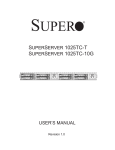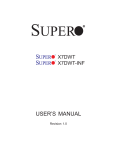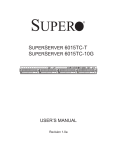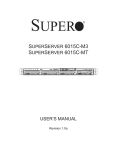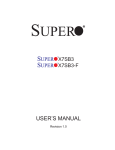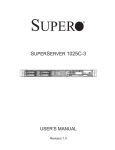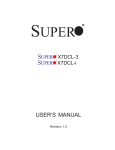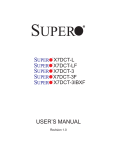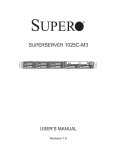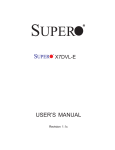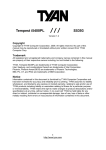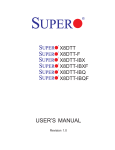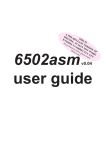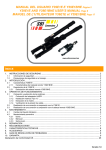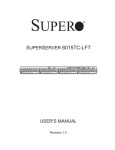Download Supermicro X7DCT
Transcript
SUPER
®
X7DCT
X7DCT-10G
USER’S MANUAL
Revision 1.0
The information in this User’s Manual has been carefully reviewed and is believed to be accurate.
The vendor assumes no responsibility for any inaccuracies that may be contained in this document,
makes no commitment to update or to keep current the information in this manual, or to notify any
person or organization of the updates. Please Note: For the most up-to-date version of this
manual, please see our web site at www.supermicro.com.
Super Micro Computer, Inc. ("Supermicro") reserves the right to make changes to the product
described in this manual at any time and without notice. This product, including software, if any,
and documentation may not, in whole or in part, be copied, photocopied, reproduced, translated or
reduced to any medium or machine without prior written consent.
IN NO EVENT WILL SUPER MICRO COMPUTER, INC. BE LIABLE FOR DIRECT, INDIRECT,
SPECIAL, INCIDENTAL, SPECULATIVE OR CONSEQUENTIAL DAMAGES ARISING FROM THE
USE OR INABILITY TO USE THIS PRODUCT OR DOCUMENTATION, EVEN IF ADVISED OF
THE POSSIBILITY OF SUCH DAMAGES. IN PARTICULAR, SUPER MICRO COMPUTER, INC.
SHALL NOT HAVE LIABILITY FOR ANY HARDWARE, SOFTWARE, OR DATA STORED OR USED
WITH THE PRODUCT, INCLUDING THE COSTS OF REPAIRING, REPLACING, INTEGRATING,
INSTALLING OR RECOVERING SUCH HARDWARE, SOFTWARE, OR DATA.
Any disputes arising between manufacturer and customer shall be governed by the laws of Santa
Clara County in the State of California, USA. The State of California, County of Santa Clara shall
be the exclusive venue for the resolution of any such disputes. Supermicro's total liability for all
claims will not exceed the price paid for the hardware product.
FCC Statement: This equipment has been tested and found to comply with the limits for a Class
A digital device pursuant to Part 15 of the FCC Rules. These limits are designed to provide
reasonable protection against harmful interference when the equipment is operated in a commercial
environment. This equipment generates, uses, and can radiate radio frequency energy and, if not
installed and used in accordance with the manufacturer’s instruction manual, may cause harmful
interference with radio communications. Operation of this equipment in a residential area is likely
to cause harmful interference, in which case you will be required to correct the interference at your
own expense.
California Best Management Practices Regulations for Perchlorate Materials: This Perchlorate
warning applies only to products containing CR (Manganese Dioxide) Lithium coin cells. “Perchlorate
Material-special handling may apply. See www.dtsc.ca.gov/hazardouswaste/perchlorate”.
WARNING: Handling of lead solder materials used in this
product may expose you to lead, a chemical known to
the State of California to cause birth defects and other
reproductive harm.
Manual Revision 1.0
Release Date: March 31, 2008
Unless you request and receive written permission from Super Micro Computer, Inc., you may not
copy any part of this document.
Information in this document is subject to change without notice. Other products and companies
referred to herein are trademarks or registered trademarks of their respective companies or mark
holders.
Copyright © 2008 by Super Micro Computer, Inc.
All rights reserved.
Printed in the United States of America
Preface
Preface
About This Manual
This manual is written for system integrators, PC technicians and
knowledgeable PC users. It provides information for the installation and use of
the
X7DCT/X7DCT-10G motherboard. The
X7DCT/X7DCT-10G
supports dual Intel Xeon Quad-Core/Dual-Core 5400/5300/5200/5100 Series
processors with a front side bus speed of up to 1.333 GHz. With dual 64-bit Xeon
Quad-Core/Dual-Core LGA 771 processors built-in, the X7DCT/X7DCT-10G offers
substantial functionality enhancements to the motherboards based on the Intel Core
microarchitecture while remaining compatible with the IA-32 software. The features
include Intel Virtualization Technology, Enhanced Intel SpeedStep technology, and
Extended Memory 64 Technology (EM64T). These features allow the motherboard
to operate at much higher speeds with better power management in much safer
thermal environments than the traditional motherboards. The X7DCT/X7DCT-10G
is ideal for intense computing environments, complex business applications and
high- end workstations. Please refer to the motherboard specifications pages on
our web site (http://www.supermicro.com/products/motherboard/) for updates. This
product is intended to be professionally installed.
Manual Organization
Chapter 1 describes the features, specifications and performance of the mainboard
and provides detailed information about the chipset.
Chapter 2 provides hardware installation instructions. Read this chapter when
installing the processor, memory modules and other hardware components into
the system. If you encounter any problems, see Chapter 3, which describes
troubleshooting procedures for the video, the memory and the system setup stored
in the CMOS.
Chapter 4 includes an introduction to the BIOS, and provides detailed information
on running the CMOS Setup utility.
Appendix A provides BIOS POST Error Codes. Appendix B and Appendix C list
the Windows OS and Other Software Programs Installation Instructions.
iii
X7DCT/X7DCT-10G User's Manual
Conventions Used in the Manual
Special attention should be given to the following symbols for proper installation and
to prevent damage done to the components or injury to yourself.
Danger/Caution: Instructions to be strictly followed to prevent catastrophic system failure or to avoid bodily injury.
Warning: Important information given to ensure proper system installation
or to prevent damage to the components.
Note: Additional Information given to differentiate various models or to
ensure correct system setup.
iv
Table of Contents
Notes
v
X7DCT/X7DCT-10G User's Manual
Table of Contents
Preface
About This Manual ........................................................................................... iii
Manual Organization ........................................................................................ iii
Conventions Used in the Manual ....................................................................... iii
Chapter 1: Introduction
1-1 Overview ............................................................................................................ 1-1
Checklist ................................................................................................... 1-1
Contacting Supermicro ............................................................................. 1-2
X7DCT/-10G Image ................................................................... 1-3
X7DCT/-10G Layout .................................................................. 1-4
Quick Reference ...................................................................................... 1-5
Motherboard Features ................................................................................ 1-6
Intel 5100 Chipset: System Block Diagram ............................................. 1-8
1-2 Chipset Overview ............................................................................................... 1-9
1-3 Special Features .............................................................................................. 1-10
1-4 PC Health Monitoring ........................................................................................ 1-10
1-5 ACPI Features ................................................................................................. 1-11
1-6 Power Supply ................................................................................................... 1-12
Chapter 2: Installation
2-1 Static-Sensitive Devices .................................................................................... 2-1
Precautions................................................................................................ 2-1
Unpacking ................................................................................................ 2-1
2-2 Processor and Heatsink Installation .................................................................. 2-2
2-3 Installing DIMMs ................................................................................................ 2-6
2-4 Control Panel Connectors and IO Ports ............................................................ 2-8
Back Panel Connectors/IO Ports................................................................... 2-8
Front Control Panel ....................................................................................... 2-9
Front Control Panel Pin Definitions ............................................................. 2-10
NMI Button ............................................................................................. 2-10
Power LED ............................................................................................. 2-10
HDD LED .............................................................................................. 2-11
NIC1/NIC2 LED Indicators ..................................................................... 2-11
Overheat/Fan Fail LED ......................................................................... 2-12
Power Fail LED ........................................................................................ 2-12
Reset Button .......................................................................................... 2-13
vi
Table of Contents
Power Button .......................................................................................... 2-13
2-5 Connecting Cables .......................................................................................... 2-14
20-Pin Proprietary Power Connector .................................................... 2-14
4-Pin Auxiliary Power Connector .......................................................... 2-15
Universal Serial Bus (USB) ..................................................................... 2-16
Fan Headers .......................................................................................... 2-16
Serial Ports ............................................................................................... 2-17
Power Supply I2C Connector.................................................................... 2-17
GLAN 1/2 (Ethernet) Ports ....................................................................... 2-18
10Gb_LAN Port ........................................................................................ 2-18
SGPIO Headers ....................................................................................... 2-19
VGA Connector ........................................................................................ 2-19
2-6 Jumper Settings ............................................................................................... 2-20
Explanation of Jumpers ......................................................................... 2-20
GLAN Enable/Disable ............................................................................ 2-20
10Gb_LAN Enable/Disable ...................................................................... 2-21
CMOS Clear ............................................................................................ 2-21
Watch Dog ................................................................................................ 2-22
VGA Enable/Disable ................................................................................. 2-22
2-7 Onboard Indicators .......................................................................................... 2-23
GLAN LEDs .............................................................................................. 2-23
10Gb_LAN LED........................................................................................ 2-23
Onboard Power LED ................................................................................ 2-24
2-8 SIMSO IPMI Connection .................................................................................. 2-25
SIMSO IPMI Slot ..................................................................................... 2-25
Chapter 3: Troubleshooting
3-1 Troubleshooting Procedures .............................................................................. 3-1
Before Power On....................................................................................... 3-1
No Power................................................................................................... 3-1
No Video .................................................................................................. 3-1
Losing the System’s Setup Configuration ................................................ 3-1
Memory Errors........................................................................................... 3-2
3-2 Technical Support Procedures ........................................................................... 3-2
3-3 Frequently Asked Questions .............................................................................. 3-3
3-4 Returning Merchandise for Service .................................................................... 3-4
Chapter 4: BIOS
4-1 Introduction .......................................................................................................... 4-1
4-2 Running Setup .................................................................................................... 4-2
vii
X7DCT/X7DCT-10G User's Manual
4-3 Main BIOS Setup ................................................................................................ 4-2
4-4 Advanced Setup ................................................................................................... 4-7
4-5 Security Setup .................................................................................................. 4-22
4-6 Boot Setup ......................................................................................................... 4-23
4-7 Exit ..................................................................................................................... 4-24
Appendices:
Appendix A: BIOS POST Error Codes ....................................................................... A-1
Appendix B: Installing the Windows OS .................................................................... B-1
Appendix C: Installing Other Software Programs and Drivers...................................C-1
vi
Chapter 1: Introduction
Chapter 1
Introduction
1-1
Overview
Checklist
Congratulations on purchasing your computer motherboard from an acknowledged
leader in the industry. Supermicro boards are designed with the utmost attention to
detail to provide you with the highest standards in quality and performance. Check
that the following items have all been included with your motherboard. If anything
listed here is damaged or missing, contact your retailer.
All the following items are included in the retail box.
•
One (1) Supermicro Mainboard
•
Two (2) SATA cables (CBL-0044L)
•
One (1) Supermicro CD containing drivers and utilities
•
One (1) User's/BIOS Manual
1-1
X7DCT/X7DCT-10G User's Manual
Contacting Supermicro
Headquarters
Address:
Super Micro Computer, Inc.
980 Rock Ave.
San Jose, CA 95131 U.S.A.
Tel:
+1 (408) 503-8000
Fax:
+1 (408) 503-8008
Email:
[email protected] (General Information)
[email protected] (Technical Support)
Web Site:
www.supermicro.com
Europe
Address:
Super Micro Computer B.V.
Het Sterrenbeeld 28, 5215 ML
's-Hertogenbosch, The Netherlands
Tel:
+31 (0) 73-6400390
Fax:
+31 (0) 73-6416525
Email:
[email protected] (General Information)
[email protected] (Technical Support)
[email protected] (Customer Support)
Asia-Pacific
Address:
Super Micro Computer, Inc.
4F, No. 232-1, Liancheng Rd.
Chung-Ho 235, Taipei County
Taiwan, R.O.C.
Tel:
+886-(2) 8226-3990
Fax:
+886-(2) 8226-3991
Web Site:
www.supermicro.com.tw
Technical Support:
Email:
[email protected]
Tel:
886-2-8228-1366, ext.132 or 139
1-2
Chapter 1: Introduction
X7DCT/X7DCT-10G Image
Note: The drawings and pictures shown in this manual were based on the
latest PCB Revision available at the time of publishing of the manual. The
motherboard you’ve received may or may not look exactly the same as the
graphics shown in the manual.
1-3
X7DCT/X7DCT-10G User's Manual
X7DCT/X7DCT-10G Motherboard Layout
VGA
COM
LED2
TLAN
LAN2
LAN1
JLAN2
JLAN1
JCOM1
JVGA1
SP1
JPA1
JPL2
SPKR
JLAN3
USB0/1
JUSB1
JPL1
Intel
82573V
LAN
CTRL
SIMSO
Intel
82573L
LAN
CTRL
Intel
82598EB
10Gb LAN CTRL
J1000
Super IO
ATI
ES1000
VGA CTRL
PCI-Exp. x16
USB2/3
SPI BIOS
JUSB2
DIMM0-0
DIMM1-0
DIMM1A
DIMM1B
DIMM2A
DIMM3B
DIMM3A
USB4
JUSB3
DIMM2B
SGPIO
J7
DIMM1-1
DIMM0-1
DIMM0-2
DIMM1-2
Battery
SATA1
JBT1
SATA3
SATA0
Intel
ICH9R
SATA2
South Bridge
JPCIE1
JPG1
Intel
5100
North Bridge
FP CTLR
LED3
JWD1
X7DCT-10G
JF1
CPU1
CPU2
JWR1
PWR1
FAN1
FAN2
FAN3
Notes:
J17
I2CPWR
JWR2
PWR_BKPlane
PWR2
JP10
•
Jumpers not indicated are for test purposes only.
•
See Chapter 2 for detailed information on jumpers, I/O ports and JF1 front panel
connections.
•
" " indicates the location of Pin 1.
•
When LED3 is on, make sure to unplug the power cable before removing or
installing components.
1-4
Chapter 1: Introduction
X7DCT/X7DCT-10G Quick Reference
Jumper
Description
Default Setting
JBT1
CMOS Clear
(See Chapter 2)
JPA1 (Note)
10Gb_LAN Enable/Disable
Pins 1-2 (Enabled)
JPL1/JPL2
Gigabit_LAN1/2 Enable/Disable
Pins 1-2 (Enabled)
JPG1
VGA Enable/Disable
Pins 1-2 (Enabled)
JWD1
Watch Dog
Pins 1-2 (Reset)
Connector
Description
COM
COM (Serial) Port
FAN 1-3
Chassis/System/CPU Fans
JF1
Front Panel Control Connector
I2C_PWR
Power Supply I2C Header (J17)
LAN1/2
Gigabit Ethernet (RJ45) Ports 1~2 (JLAN1/JLAN2)
TLAN (Note)
10Gb_LAN Port (JLAN3)
PWR1/PWR2
20-Pin Power Connectors 1~2 (JWR1/JWR2)
PWR_BK_plane
Backplane Power Connector (JP10)
SATA0 ~3
Intel (South Bridge) SATA Ports 0~3
SGPIO
Serial General Purpose I/O Header (J7)
SIMSO
SIMSO (Remote Management) IPMI Slot (J1000)
SPKR
Internal Speaker/Buzzer (SP1)
USB 0~1
Back Panel Universal Serial Bus (USB) Ports#0~1
USB 2~3, 4
Front Panel/Embedded USB Headers#2~3(JUSB2), #4
(JUSB3)
VGA
VGA Connectors (JVGA1)
LED Indicator
Description
LED2 (Note)
10 Gigabit_LAN LED
LED3
Onboard Power LED
Note: For X7DCT-10G only
1-5
X7DCT/X7DCT-10G User's Manual
Motherboard Features
CPU
•
Dual Intel® 64-bit Xeon LGA 771 Quad-Core/Dual-Core 5400/5300/5200/5100
Series processors at a front side bus speed of 1333 MHz or 1066 MHz
Memory
•
Six 240-pin DIMM sockets with support up to 48 GB ECC Buffered (Registered)
DDR2 667/533 Memory (*See Section 2-3 in Chapter 2 for DIMM Slot Population.)
Chipset
•
Intel 5100 chipset, including: the 5100 Memory Control Hub (MCH), and the
ICH9R South Bridge
Expansion Slots
•
•
One PCI-Exp. x16 slot (JPCIE1)
One SIMSO IPMI Slot
BIOS
•
•
16 Mb SPI Phoenix® Flash ROM*
DMI 2.3, PCI 2.2, ACPI 1.0/2.0/3.0, Plug and Play (PnP), USB Keyboard support,
and Hardware BIOS Virus Protection
Note: The onboard SPI BIOS chip is not removable. To repair or replace
the onboard BIOS chip, please return the motherboard to Supermicro
for service.
PC Health Monitoring
•
Onboard voltage monitors for CPU core voltage, Memory voltage, Chipset,
+1.5V, +3.3V, +5V, +12V, +5V standby and VBAT)
•
•
•
•
•
•
•
•
•
•
•
Fan status monitor with firmware control
CPU/chassis temperature monitors
Low noise fan speed control
CPU fan auto-off in sleep mode
Pulse Width Modulation (PWM) fan control
2
I C temperature sensing logic
Thermal Monitor 2 (TM2) support
CPU slow-down on temperature overheat
CPU thermal trip support for processor protection
Power-up mode control for recovery from AC power loss
PECI (Platform Environment Configuration Interface) support
1-6
Chapter 1: Introduction
•
System resource alert via Supero Doctor III
ACPI Features
•
•
•
•
Slow blinking LED for suspend state indicator
Main switch override mechanism
ACPI Power Management
Power-on mode for power recovery
Onboard I/O
•
Four SATA ports (supporting RAID 0, 1,10 and 5 in the Windows OS environment; RAID 0, 1 and 10 in Unix)
•
•
One SIMSO IPMI socket
Intel 82573V and 82573L LAN chips support two Giga-bit LAN ports and Intel
82598EB chip supports a 10Gb_LAN port with CX4 interface
•
•
•
One COM port
Up to five USB 2.0 (Universal Serial Bus) (three ports, one header)
Super I/O: Winbond W83627HG-AW
Other
•
•
•
•
Console redirection
Onboard Fan Speed Control by Thermal Management via BIOS
CD/Diskette Utilities
BIOS flash upgrade utility and device drivers
Dimensions
•
Extended ATX 16.4" (L) x 6.5" (W) (416.6 mm x 165.1 mm)
1-7
X7DCT/X7DCT-10G User's Manual
PROCESSOR#2
VRD
ISL6327
PROCESSOR#1
1333/1067
MT/S
1333/1067
MT/S
#3A
#2A
#1A
PCI-Exp x16
#3E
#2B
#1B
MCH
Intel 5100
DDR2 667
DDR2 667
PCI-Exp x16
VRD
ISL6327
JLAN3 10.0 Gb/S Oplin PCI-Exp x8
82598
CX4
PCI-Exp x4
DMI
JLAN1
RJ45
LAN 1
82573V
PCI-Exp x1
JLAN2
RJ45
LAN2
PCI-Exp x1
82573L
LANE5
3.0 Gb/S
ICH9R
LANE6
GDDR2 SDRAM 32MB
VGA
ES1000
#4
#3
#2
#1
#0
USB 2.0
USB
VGA
CONN
SATA
#3
#2
#1
#0
PCI 33MHz
LPC
SPI
SIO
W83627HG-AW
COM1
External
SPI Flash
COM2
SOL
Block Diagram
Note: This is a general block diagram. Please see the previous Motherboard Features pages for details on the features of each motherboard.
1-8
Chapter 1: Introduction
1-2
Chipset and Processor Features Overview
Built upon the functionality and the capability of the Intel 5100 chipset, the X7DCT/
X7DCT-10G motherboard provides the performance and feature set required for
dual processor-based high-end computer systems with configuration options optimized for intensive computing, high energy-efficiency and complex business applications. The 5100 chipset supports single or dual Intel Xeon 64-bit Quad-Core/
Dual-Core 5400/5300/5200/5100 Series processors with front side bus speeds of
up to 1.333 GHz. The chipset consists of the 5100 Memory Controller Hub (MCH),
Intel I/O Controller Hub (ICH9R) and the I/O subsystem.
The 5100 Memory Controller Hub (MCH)
The Intel 5100 MCH chip is designed for symmetric multiprocessing across two
independent front side bus interfaces. Each front side bus uses a 64-bit wide,
1333/1066 MTS data bus capable of transferring data at 8.5/10.6 GB/s for a total
bandwidth of 17/21.3 GB/s. The MCH supports a 36-bit wide address bus and up to
six DDR2 667 MHz/533 MHz Registered DIMM modules, providing a total memory
capacity of up to 48 GB.
The 5100 MCH also provides one x16, one x8 PCI-Express interfaces and one x4
DMI Interface to the ICH9R. Each PCI Express port on the MCH provides 4 GB/s
bi-directional bandwidth.
The Ninth Generation I/O Controller Hub (ICH9R)
The I/O Controller ICH9R provides the data buffering and interface arbitration required for the system to operate efficiently. It also provides the bandwidth needed
for the system to maintain its peak performance. The Direct Media Interface (DMI)
provides the connection between the MCH and the ICH9R. The ICH9R supports up
to three PCI-Express x1 connections, one PCI connection, four Serial ATA ports and
five USB 2.0 ports. In addition, the ICH9R offers the Intel Matrix Storage Technology
which provides various RAID options for data protection and rapid data access. It
also supports next generation of client management through the use of PROActive
technology in conjunction with Intel's next generation Gigabit Ethernet controllers.
1-9
X7DCT/X7DCT-10G User's Manual
1-3
Special Features
Recovery from AC Power Loss
BIOS provides a setting for you to determine how the system will respond when
AC power is lost and then restored to the system. You can choose for the system
to remain powered off (in which case you must hit the power switch to turn it
back on) or for it to automatically return to a power- on state. See the Power Lost
Control setting in the Advanced BIOS Setup section to change this setting. The
default setting is Last State.
1-4
PC Health Monitoring
This section describes the PC health monitoring features of the X7DCT/X7DCT10G. All have an onboard System Hardware Monitor chip that supports PC health
monitoring.
Voltage Monitoring
An onboard voltage monitor will scan the CPU Core, Chipset, +1.5V, +3.3V, +5V,
+12V, +5V Standby and VBAT voltages continuously. Once a voltage becomes
unstable, a warning is given or an error message is sent to the screen.
Fan Status Monitor with Firmware Control
The PC health monitor can check the RPM status of the cooling fans. The onboard
CPU and chassis fans are controlled by Thermal Management via BIOS (under
Hardware Monitoring in the Advanced Setting).
Environmental Temperature Control
The thermal control sensor monitors the CPU temperature in real time and will turn
on the thermal control fan whenever the CPU temperature exceeds a user-defined
threshold. The overheat circuitry runs independently from the CPU. Once it detects
that the CPU temperature is too high, it will automatically turn on the thermal fan
control to prevent any overheat damage to the CPU. The onboard chassis thermal
circuitry can monitor the overall system temperature and alert users when the chassis temperature is too high.
1-10
Chapter 1: Introduction
System Resource Alert
This feature is available when used with Supero Doctor III in the Windows OS
environment or used with Supero Doctor II in Linux. Supero Doctor is used to
notify the user of certain system events. For example, if the system is running
low on virtual memory and there is insufficient hard drive space for saving the
data, you can be alerted of the potential problem. You can also configure Supero
Doctor to provide you with warnings when the system temperature goes beyond
a pre-defined range.
1-5
ACPI Features
ACPI stands for Advanced Configuration and Power Interface. The ACPI specifi cation defines a flexible and abstract hardware interface that provides a standard
way to integrate power management features throughout a PC system, including
its hardware, operating system and application software. This enables the system
to automatically turn on and off peripherals such as CD-ROMs, network cards,
hard disk drives and printers. This also includes consumer devices connected to
the PC such as VCRs, TVs, telephones and stereos.
In addition to enabling operating system-directed power management, ACPI
provides a generic system event mechanism for Plug and Play and an operating system-independent interface for configuration control. ACPI leverages the
Plug and Play BIOS data structures while providing a processor architectureindependent implementation that is compatible with Windows 2000, Windows XP,
Windows Vista and Windows 2003 Servers operating systems.
Slow Blinking LED for Suspend-State Indicator
When the CPU goes into a suspend state, the chassis power LED will start blinking
to indicate that the CPU is in suspend mode. When the user presses any key, the
CPU will wake-up and the LED will automatically stop blinking and remain on.
Main Switch Override Mechanism
When a power supply is used, the power button can function as a system suspend
button to make the system enter a SoftOff state. The monitor will be suspended and
the hard drive will spin down. Pressing the power button again will cause the whole
system to wake-up. During the SoftOff state, the power supply provides power to
keep the required circuitry in the system alive. In case the system malfunctions and
you want to turn off the power, just press and hold the power button for 4 seconds.
This option can be set in the Power section of the BIOS Setup routine.
1-11
X7DCT/X7DCT-10G User's Manual
1-6
Power Supply
As with all computer products, a stable power source is necessary for proper and
reliable operation. It is even more important for processors that have high CPU
clock rates.
The X7DCT/X7DCT-10G can only accommodate Supermicro proprietary power
supply. Please refer to Section 2-5 for detailed information.
1-12
Chapter 2: Installation
Chapter 2
Installation
2-1
Static-Sensitive Devices
Electro-Static-Discharge (ESD) can damage electronic components. To prevent
damage to your system board, it is important to handle it very carefully. The following
measures are generally sufficient to protect your equipment from ESD.
Precautions
•
•
•
Use a grounded wrist strap designed to prevent static discharge.
Touch a grounded metal object before removing the board from the antistatic
bag.
Handle the board by its edges only; do not touch its components, peripheral
chips, memory modules or gold contacts.
•
When handling chips or modules, avoid touching their pins.
•
Put the motherboard and peripherals back into their antistatic bags when not
in use.
•
For grounding purposes, make sure your computer chassis provides excellent
conductivity between the power supply, the case, the mounting fasteners and
the motherboard.
•
Use only the correct type of onboard CMOS battery as specified by the
manufacturer. Do not install the onboard battery upside down to avoid possible
explosion.
Unpacking
The motherboard is shipped in antistatic packaging to avoid static damage. When
unpacking the board, make sure the person handling it is static protected.
2-1
X7DCT/X7DCT-10G User's Manual
2-2
Processor and Heatsink Fan Installation
!
Warning: When handling the processor package, avoid placing
direct pressure on the label area of the fan.
Notes:
1. Always connect the power cord last and always remove it before adding,
removing or changing any components. Make sure that you install the processor into the CPU socket before you install the CPU heatsink.
2. Intel's boxed Xeon CPU package contains the CPU fan and heatsink assembly. If you buy a CPU separately, make sure that you use only Intel-certified
multi-directional heatsink and fan.
3. Make sure to install the motherboard into the chassis before you install the
CPU heatsink and fan.
4. When purchasing a motherboard with an LGA 771 CPU Socket, make sure
that the CPU plastic cap is in place, and none of the CPU Socket pins are
bent; otherwise, contact the retailer immediately.
5. Refer to the Chipset/MB Features Section for more details on CPU support.
Installing the LGA771 Processor
1. Press the load lever to release
the load plate, which covers the
CPU socket, from its locking
position.
PnP Cap on
top of the
Load Plate
Load Lever
2. Gently lift the load lever to open
the load plate.
3. Use your thumb and your index
finger to hold the CPU at the
North Center Edge and the South
Center Edge of the CPU.
Load Plate
(with PnP Cap
attached)
2-2
Chapter 2: Installation
Loading the Processor into the Socket
North
1. Align CPU Pin1 (the CPU corner
Center
marked with a triangle) against the
Edge
socket corner that is marked with a
South
Center
triangle cutout.
Edge
2. Align the CPU key that is the
semi-circle cutout below a gold dot
Socket Key
against the socket key, the notch
(Socket Notch)
on the same side of the triangle
cutout on the socket.
gold dot
CPU Key (semi-
circle cutout)
3. Once aligned, carefully lower the below the circle.
CPU straight down to the socket.
(Do not drop the CPU on the Corner with a
socket. Do not move the CPU triangle cutout
horizontally or vertically. Do not
rub the CPU against the surface
Load Lever
or against any pins of the socket
to avoid damage to the CPU or
the socket.)
CPU in the
CPU socket
4. With the CPU installed in the
socket, inspect the four corners of
the CPU to make sure that the CPU
is properly installed. Then, close
the load plate.
CPU Pin1
5. Use your thumb to gently push the
load lever down to lock it.
6. If the CPU is properly installed into
the socket, the plastic cap will be
automatically released from the
load plate when the clip is pushed
in the clip lock. Remove the plastic
cap from the motherboard.
!
Plastic cap is
released from
the load plate
if the CPU
properly installed.
Warning: Please save the plastic PnP cap. The motherboard must
be shipped with the PnP cap properly installed to protect the CPU
socket pins. Shipment without the PnP cap properly installed will
cause damage to the socket pins.
2-3
X7DCT/X7DCT-10G User's Manual
Installing the Heatsink
CEK Heatsink Installation
CEK Passive Heatsink
1. Do not apply any thermal grease to the
heatsink or the CPU die; the required
amount has already been applied.
2. Place the heatsink on top of the CPU
so that the four mounting holes are
Screw#1
Screw#2
aligned with those on the retention
mechanism.
3. Screw in two diagonal screws (ie the #1
and the #2 screws) until just snug (-do
not fully tighten the screws to avoid
possible damage to the CPU.)
Screw#1
4. Finish the installation by fully tightening
all four screws.
Screw#2
Uninstalling the Heatsink
!
Warning: We do not recommend that the CPU or the heatsink be
removed. However, if you do need to uninstall the heatsink, please
follow the instructions on the next page to uninstall the heatsink to
prevent damage done to the CPU or the CPU socket.
2-4
Chapter 2: Installation
1. Unscrew and remove the heatsink
screws from the motherboard in the
sequence as shown in the picture on
the right.
2. Hold the heatsink as shown in the picture on the right and gently wriggle the
heatsink to loosen it from the CPU. (Do
not use excessive force when wriggling
the heatsink!!)
3. Once the heatsink is loosened, remove
the heatsink from the CPU socket.
4. Clean the surface of the CPU and the
heatsink to get rid of the old thermal
grease. Reapply the proper amount
of thermal grease on the surface before you re-install the CPU and the
heatsink.
Mounting the Motherboard in the Chassis
All motherboards have standard mounting holes to fit different types of chassis.
Make sure that the locations of all the mounting holes for both motherboard and
chassis match. Make sure that the metal standoffs click in or are screwed in tightly.
Then, use a screwdriver to secure the motherboard onto the motherboard tray.
Note: some components are very close to the mounting holes. Please take
precautionary measures to prevent damage done to these components when
you install the motherboard into the chassis.
2-5
X7DCT/X7DCT-10G User's Manual
2-3
Installing DIMMs
Warning! Exercise extreme care when installing or removing DIMM
modules to prevent any possible damage. Also note that the memory is
interleaved to improve performance. (See Memory Support below.)
DIMM Installation
Insert a desired number of modules into slots. (A minimum of two modules is required.) Gently press down on a module until it snaps into place in the slot. The
memory scheme is interleaved, so you must install two modules at a time, beginning
with DIMM 1A and DIMM 1B, DIMM 2A and DIMM 2B, then DIMM 3A, DIMM 3B.
Memory Support
The X7DCT/X7DCT-10G supports up to 48 GB ECC Registered DDR2 667/533 in 6
DIMMs. Populating memory slots of the same bank with a pair of memory modules
of the same size and same type will result in two-way Interleaved Memory which
will improve memory performance. See the table below.
Optimized DIMM Population Configurations
No. of
DIMMs
2DIMMs
4DIMMs
6DIMMs
Channel 0
DIMM1A
DIMM1A
DIMM1A
-----DIMM2A
DIMM2A
Channel 1
----------DIMM3A
DIMM1B
DIMM1B
DIMM1B
-----DIMM2B
DIMM2B
----------DIMM3B
(Notes: i. DIMM slot# specified: DIMM slot to be populated; “---“: DIMM slot not to be
populated. ii. Both 533 MHz and 667MHz DIMMs are supported; however, you need to use
the memory modules of the same speed and of the same type on a motherboard. iii. For
memory to work properly, you need to follow the restrictions listed above. )
Notes:
1. Due to OS limitations, some operating systems may not show more than 4
GB of memory.
2. This motherboard supports both dual-rank and single-rank memory modules.
For system memory to work properly, please use all dual-rank memory modules or use all single-rank memory modules on the same motherboard. Check
the Supermicro web site for other information.
3. Due to memory allocation to system devices, memory remaining available
for operational use will be reduced when 4 GB of RAM is used. The reduction
in memory availability is disproportional. (Refer to the following Memory Availability Table for details.
2-6
Chapter 2: Installation
Possible System Memory Allocation & Availability
System Device
Size
Physical Memory
Remaining (-Available)
(4 GB Total System Memory)
Firmware Hub flash memory (System BIOS)
1 MB
3.99
Local APIC
4 KB
3.99
Area Reserved for the chipset
2 MB
3.99
I/O APIC (4 Kbytes)
4 KB
3.99
PCI Enumeration Area 1
256 MB
3.76
PCI Express (256 MB)
256 MB
3.51
PCI Enumeration Area 2 (if needed) -Aligned on 256MB boundary-
512 MB
3.01
VGA Memory
16 MB
2.85
TSEG
1 MB
2.84
Memory available to OS and other applications
2.84
DIMM1B
Intel
82573V
LAN
CTRL
LAN1
JPL1
I2CPWR
LED3
DIMM1A
FAN1
DIMM2B
SIMSO
DIMM2A
LAN2
JWR1
USB0/1
JF1
Installing and Removing DIMMs
JWD1
CPU1
DIMM3B
COM
Intel
82573L
LAN
CTRL
Super IO
DIMM3A
JBT1
SPI BIOS
ATI
ES1000
VGA CTRL
Intel
Battery
Intel
ICH9R
VGA
SPKR
FAN2
X7DCT-10G
JPG1
JPL2
Intel
5100
South Bridge
FAN3
North Bridge
CPU2
LED2
USB2/3
10Gb LAN CTRL
JPA1
TLAN
82598EB
PCI-Exp. x16
To I n s t a l l: Inser t
module vertically and
press down until it
snaps into place. Pay
attention to the alignment notch at the
bottom.
PWR_BKPlane
SATA3
SATA1
SATA2
SATA0
SGPIO
JWR2
USB4
DDR2 ECC (Buffered) Memory
Notch
Release Tab
Notch
Release Tab
To Remove:
Use your thumbs to
gently push the reTop View of DDR2 ECC Slot
lease tabs near both Release Tab
ends of the module
to release it from the
slot.
2-7
Release Tab
X7DCT/X7DCT-10G User's Manual
2-4
Control Panel Connectors/IO Ports
The I/O ports are color coded in conformance with the PC 99 specification. See
the graphics below for the colors and locations of the various I/O ports.
Back Panel Connectors/IO Ports
X7DCT-10G
2
1
3
4
6
5
7
Back Panel I/O Port Locations and Definitions
Back Panel Connectors
1
USB 0
2
USB 1
3
Gb_LAN1
4
Gb_LAN2
5
COM 1 (Turquoise)
6
VGA (Blue)
7
10Gb_LAN (X7DCT-10G only)
(See Section 2-5 for details.)
2-8
Chapter 2: Installation
Front Control Panel
JF1 contains header pins for various buttons and indicators that are normally located on a control panel at the front of the chassis. These connectors are designed
specifically for use with Supermicro server chassis. See the figure below for the
descriptions of the various control panel buttons and LED indicators. Refer to the
following section for descriptions and pin definitions.
Front Control Panel Header (JF1) Pins
20 19
X7DCT-10G
2 1
20
19
Ground
NMI
X
X
Power LED
3.3Vcc
HDD LED
3.3Vcc
NIC1 LED
3.3Vsb
NIC2 LED
3.3Vsb
OH/Fan Fail
3.3Vcc
5Vcc
PWR Fail LED
Ground
Reset Button
Ground
Power Button
2
2-9
1
X7DCT/X7DCT-10G User's Manual
Front Control Panel Pin Definitions
NMI Button
NMI Button
Pin Definitions (JF1)
The non-maskable interrupt button
header is located on pins 19 and 20
of JF1. Refer to the table on the right
Pin#
Definition
19
NMI Control
for pin definitions.
20
Ground
Power LED
Power LED
Pin Definitions (JF1)
The Power LED connection is located
on pins 15 and 16 of JF1. Refer to the
table on the right for pin definitions.
Pin#
Definition
15
3.3 Vcc
16
Power On Indicator
A. NMI
B. PWR LED
20
19
Ground
NMI
X
A
X
B Power LED
3.3Vcc
HDD LED
3.3Vcc
NIC1 LED
3.3Vsb
NIC2 LED
3.3Vsb
OH/Fan Fail
3.3Vcc
X7DCT-10G
5Vcc
PWR Fail LED
Reset Button
Ground
Power Button
Ground
2
2-10
1
Chapter 2: Installation
HDD LED
The HDD LED connection is located
on pins 13 and 14 of JF1. Attach a
hard drive LED cable here to display
disk activity. See the table on the right
for pin definitions.
HDD/UID LED
Pin Definitions (JF1)
Pin#
Definition
13
3.3 Vcc
14
HD Active
NIC1/NIC2 LED Indicators
The NIC (Network Interface Controller) LED connection for GLAN port1 is
located on pins 11 and 12 of JF1 and
the LED connection for GLAN Port2
is on Pins 9 and 10. Attach the NIC
LED cables to display network activity.
Refer to the table on the right for pin
definitions.
GLAN1/2 LED
Pin Definitions (JF1)
Pin#
Definition
9/11
3.3 Vsb
10/12
NIC Active
A. HDD LED
B. NIC1 LED
C. NIC2 LED
20
19
Ground
NMI
X
X7DCT-10G
X
Power LED
3.3Vcc
A HDD LED
3.3Vcc
B
NIC1 LED
3.3Vsb
C NIC2 LED
3.3Vsb
OH/Fan Fail
3.3Vcc
5Vcc
PWR Fail LED
Reset Button
Ground
Power Button
Ground
2
2-11
1
X7DCT/X7DCT-10G User's Manual
Overheat/Fan Fail LED (OH)
Connect an LED to the OH/Fan Fail
connection on pins 7 and 8 of JF1 to
provide advanced warnings of chassis
overheating or fan failure. Refer to the
OH/Fan Fail LED
Pin Definitions (JF1)
Pin#
Definition
7
3.3 Vcc
8
OH/Fan Fail LED Indicator
table on the right for pin definitions.
OH/Fan Fail Indicator
Status
State
Definition
Off
Normal
On
Overheat
Flashing
Fan Fail
Power Fail LED
The Power Fail LED connection is
located on pins 5 and 6 of JF1. Refer
to the table on the right for pin definitions.
PWR Fail LED
Pin Definitions (JF1)
Pin#
Definition
5
5 Vcc
6
PWR Fail Indicator
A. OH/Fan Fail LED
B. PWR Supply Fail
20
19
Ground
NMI
X
X
Power LED
3.3Vcc
HDD LED
3.3Vcc
NIC1 LED
3.3Vsb
NIC2 LED
3.3Vsb
A OH/Fan Fail
3.3Vcc
X7DCT-10G
5Vcc
B PWR Fail LED
Ground
Reset Button
Ground
Power Button
2
2-12
1
Chapter 2: Installation
Reset Button
The Reset Button connection is located
on pins 3 and 4 of JF1. Attach it to the
hardware reset switch on the computer
case. Refer to the table on the right for
Reset Button
Pin Definitions (JF1)
Pin#
Definition
3
Reset Signal
4
Ground
pin definitions.
Power Button
The Power Button connection is located
on pins 1 and 2 of JF1. Momentarily contacting both pins will power on/off the system. This button can also be configured
to function as a suspend button (with a
setting in the BIOS - see Chapter 4). To
turn off the power when set to suspend
mode, press the button for at least 4
seconds. Refer to the table on the right
for pin definitions.
Power Button
Pin Definitions (JF1)
Pin#
Definition
1
PWR Button Signal
2
Ground
A. Reset Button
B. PWR Button
20
19
Ground
NMI
X
X7DCT-10G
X
Power LED
3.3Vcc
HDD LED
3.3Vcc
NIC1 LED
3.3Vsb
NIC2 LED
3.3Vsb
OH/Fan Fail
3.3Vcc
5Vcc
PWR Fail LED
Ground
Ground
2
2-13
1
Reset Button
A
Power Button
B
X7DCT/X7DCT-10G User's Manual
2-5
Connecting Cables
20-pin Proprietary Power
Connectors
20-pin Main Power Connector
Pin Definitions
Pin#
Definition
Pin #
11
PS On
1
Ground
auxiliary power connector (JP10) on the
12
5VSB
2
Ground
motherboard. These power connectors
meet the SSI EPS 12V specification. For
13
Ground
3
Ground
14
Ground
4
Ground
power supply to work properly, please
15
Ground
5
Ground
follow the instructions given below. See
16
NC2
6
NC1
the table on the right for pin definitions.
Also refer to the layout below for the
PWR connector locations.
17
12V
7
12V
18
12V
8
12V
19
12V
9
12V
20
12V
10
12V
There are two 20-pin main power supply
connectors (JWR1, JWR2) and a 4-pin
Definition
Note 1: You cannot use both 20-pin power connectors located at JWR1
(the right connector) and JWR2 (the left connector) as input power supply
connectors at the same time. Only one connector can be used for input
power supply to the motherboard at a time. For proper use of these proprietary PWR Connectors, please customize your PWR cables based on
the SMC PWR Connector Pin-Out Definitions listed above.
Note 2: The black square (dot) on a power connector indicates the location of Pin 1. (See the pictures below for the power cable connections.)
A. The right 20-pin PWR connector: (JWR1)
C
B. The left 20-pin PWR connector: (JWR2)
LAN1
JLAN1
LAN2
JLAN2
Intel
82573L
LAN
CTRL
DIMM2B
DIMM0-1
DIMM2A
DIMM1-2
DIMM3B
DIMM0-2
DIMM3A
JWD1
CPU1
Super IO
JBT1
SPKR
ES1000
VGA CTRL
FAN2
X7DCT-10G
Battery
JPG1
ATI
SPI BIOS
SP1
LED2
I2CPWR
PWR1
FAN1
JVGA1
VGA
DIMM1-1
A
FP CTLR
LED3
J1000
Intel
Intel
ICH9R
Intel
5100
South Bridge
North Bridge
FAN3
CPU2
PCI-Exp. x16
JUSB2
USB2/3
82598EB
10Gb LAN CTRL
JPA1
TLAN
DIMM1A
PWR_BKPlane
JPCIE1
SATA3
SATA1
SATA2
SATA0
USB4
SGPIO
J7
JUSB3
2-14
B
PWR2
JP10
JCOM1
SIMSO
DIMM1B
JPL2
JLAN3
COM
JPL1
DIMM1-0
DIMM0-0
J17
Intel
82573V
LAN
CTRL
JWR1
JF1
JUSB1
USB0/1
C. 20-pin PWR Cable
JWR2
Chapter 2: Installation
4-pin Auxiliary Power Connector
In addition to two 20-pin power connectors, a 4-pin 12V PWR supply is located
4-Pin Power
Pin Definitions
at JP10 on the motherboard. This power
connector is used to provide power sup-
Pin #
ply to hard drive disks. Refer to the layout
below for the location.
Note1: The 4-pin Auxiliary Power Connector is used for power
supply output to the HDDs
Definition
1
+12V
2
Ground
3
Ground
4
+5V
only.
Required Connection
Note 2: The black square (dot)
on the power connector indicates the location of Pin 1. (See
the pictures below for the power
cable connections.)
D
A. 4-pin Aux. PWR
C
B. One Male (Receptacle)
PWR Connector
C.& D. Two Female PWR
Connectors
A
B
DIMM1B
Intel
82573V
LAN
CTRL
LAN1
JPL1
I2CPWR
LED3
DIMM1A
FAN1
DIMM2B
SIMSO
DIMM2A
LAN2
JWR1
USB0/1
JF1
B
JWD1
CPU1
DIMM3B
COM
Intel
82573L
LAN
CTRL
Super IO
DIMM3A
JBT1
SPI BIOS
ATI
ES1000
VGA CTRL
VGA
SPKR
Intel
Battery
JPG1
JPL2
FAN2
X7DCT-10G
Intel
ICH9R
Intel
5100
South Bridge
North Bridge
FAN3
CPU2
LED2
USB2/3
JPA1
TLAN
82598EB
10Gb LAN CTRL
PCI-Exp. x16
A
SATA3
SATA1
SATA2
SATA0
USB4
SGPIO
2-15
JWR2
PWR_BKPlane
X7DCT/X7DCT-10G User's Manual
Universal Serial Bus (USB)
Back Panel USB
(USB 0~1)
There are five USB 2.0 (Universal Serial
Bus) ports/headers on the motherboard.
Pin#
Definitions
Two of them are Back Panel USB ports:
USB 0~1 (JPUSB1). The other four are
1/5
+5V
2/6
PO-
Front Panel/Embedded USB connectors:
3/7
PO+
USB 2~3 (JUSB2), and USB 4 (JUSB3).
4/8
Ground
See the tables on the right for pin defini-
Front Panel USB
Pin Definitions (USB 2~4)
tions.
USB 2/3
Pin #
Definition
USB 4
Pin #
Definition
1
+5V
1
+5V
2
PO-
2
PO-
3
PO+
3
PO+
4
Ground
4
Ground
5
Key
5
No connection
Fan Headers
Fan Header
Pin Definitions
The X7DCT/X7DCT-10G has three
system fan headers (Fans 1~Fan 3). All
these fans are 4-pin fans. See the table
on the right for pin definitions.
Note: The onboard fan speeds are
controlled by Thermal Management
via BIOS Hardware Monitoring in the
Advanced Setting. (The default setting is Disabled.)
Pin#
Definition
1
Ground
2
+12V
3
Tachometer
4
PWR Modulation
A. Backpanel USB 0~1
B. Front Panel USB 2~3
C. Front Panel USB 4
D. Fan 1
E. Fan 2
USB0/1
A
LAN1
JPL1
I2CPWR
LED3
DIMM1A
D
DIMM2A
JWD1
CPU1
DIMM3B
COM
Intel
82573L
LAN
CTRL
E
Super IO
DIMM3A
JBT1
SPI BIOS
ATI
ES1000
VGA CTRL
VGA
B
Intel
FAN2
X7DCT-10G
Battery
JPG1
JPL2
SPKR
FAN1
DIMM2B
SIMSO
LAN2
JWR1
JF1
F. Fan 3
DIMM1B
Intel
82573V
LAN
CTRL
Intel
ICH9R
F
Intel
5100
South Bridge
North Bridge
FAN3
CPU2
LED2
USB2/3
JPA1
TLAN
82598EB
10Gb LAN CTRL
PCI-Exp. x16
SATA3
SATA1
SATA2
SATA0
PWR_BKPlane
C
SGPIO
USB4
2-16
JWR2
Chapter 2: Installation
Serial Port
Serial Port Pin Definitions
The onboard serial port is located at
Pin #
JCOM1 on the motherboard. See the
1
DCD
6
DSR
table on the right for pin definitions.
2
RXD
7
RTS
3
TXD
8
CTS
4
DTR
9
RI
5
Ground
10
NC
Definition
Pin #
Definition
PWR Supply I2C
Pin Definitions
Power Supply I2C Connector
Power Supply (I2C) Connector (J17)
monitors the status of the power
supply, fan and system temperature.
See the table on the right for pin
definitions.
Pin#
Definition
1
Clock
2
Data
3
PWR Fail
4
Ground
A. COM Port
B. PWR Supply I2C
LAN1
JPL1
LED3
FAN1
DIMM2B
SIMSO
LAN2
I2CPWR
DIMM1A
DIMM2A
JWD1
CPU1
DIMM3B
Intel
82573L
LAN
CTRL
Super IO
DIMM3A
A
COM
JWR1
USB0/1
JF1
B
DIMM1B
Intel
82573V
LAN
CTRL
JBT1
SPI BIOS
ATI
ES1000
VGA CTRL
VGA
SPKR
Intel
Battery
JPG1
JPL2
FAN2
X7DCT-10G
Intel
ICH9R
Intel
5100
South Bridge
North Bridge
FAN3
CPU2
LED2
USB2/3
JPA1
TLAN
82598EB
10Gb LAN CTRL
PCI-Exp. x16
PWR_BKPlane
SATA3
SATA1
SATA2
SATA0
USB4
SGPIO
2-17
JWR2
X7DCT/X7DCT-10G User's Manual
GLAN 1/2 (Giga-bit Ethernet
Ports)
Two Gigabit Ethernet ports are loGLAN1/2
cated at JLAN1/JLAN2 on the I/O
backplane. These ports accept RJ45
type cables.
10Gb_LAN Port (For X7DCT10G Only)
In addition to the two GLAN ports
mentioned above, a 10_ Gigabit LAN
(TLAN) w/CX4 interface is located at
JLAN3 on the I/O backplane. Refer to
the layout below for the locations of
the LAN ports.
A. Gb_LAN1
B. Gb_LAN2
LAN1
DIMM1B
Intel
82573V
LAN
CTRL
JPL1
A
LAN2
COM
I2CPWR
LED3
DIMM1A
FAN1
DIMM2B
SIMSO
DIMM2A
B
JWR1
USB0/1
JF1
C. 10 Gb_LAN
JWD1
CPU1
DIMM3B
Intel
82573L
LAN
CTRL
Super IO
DIMM3A
JBT1
SPI BIOS
ATI
ES1000
VGA CTRL
VGA
SPKR
Intel
Battery
JPG1
JPL2
FAN2
X7DCT-10G
Intel
ICH9R
Intel
5100
South Bridge
North Bridge
FAN3
CPU2
LED2
USB2/3
10Gb LAN CTRL
JPA1
TLAN
82598EB
C
PCI-Exp. x16
PWR_BKPlane
SATA3
SATA1
SATA2
SATA0
JWR2
USB4
SGPIO
2-18
Chapter 2: Installation
SGPIO Header
A SGPIO (Serial-Link General Purpose Input/Output) header is located
SGPIO
Pin Definitions
Pin#
Definition
Pin
Definition
er is used to communicate with the
1
NC
2
NC
Serial-Link System Monitoring chip
on the backplane. See the table on
3
Ground
4
DATA Out
5
Load
6
Ground
the right for pin definitions. Refer to
7
Clock
8
NC
at J7 on the motherboard. This head-
the board layout below for the loca-
NC: No Connections
tions of the headers.
VGA Connector
A VGA connector (JVGA1) is located
next to the COM1 port on the IO
backplane. Refer to the board layout
below for the location.
A. SGPIO
DIMM1B
Intel
82573V
LAN
CTRL
LAN1
JPL1
FAN1
DIMM2B
SIMSO
LAN2
I2CPWR
LED3
DIMM1A
DIMM2A
JWD1
CPU1
DIMM3B
COM
Intel
82573L
LAN
CTRL
Super IO
DIMM3A
JBT1
SPI BIOS
ATI
ES1000
VGA CTRL
SPKR
B
Intel
FAN2
X7DCT-10G
Battery
JPG1
JPL2
VGA
JWR1
USB0/1
JF1
B. VGA
Intel
ICH9R
Intel
5100
South Bridge
North Bridge
FAN3
CPU2
LED2
USB2/3
JPA1
TLAN
82598EB
10Gb LAN CTRL
PCI-Exp. x16
PWR_BKPlane
SATA3
SATA1
SATA2
SATA0
A
JWR2
USB4
SGPIO
2-19
X7DCT/X7DCT-10G User's Manual
2-6
Jumper Settings
Explanation of Jumpers
Connector
Pins
To modify the operation of the mother-
3
2
1
3
2
1
board, jumpers can be used to choose
between optional settings. Jumpers
create shorts between two pins to
Jumper
Cap
change the function of the connector.
Pin 1 is identified with a square solder
pad on the printed circuit board. See
the motherboard layout pages for
Setting
Pin 1-2 short
jumper locations.
Note: On two pin jumpers,
"Closed" means the jumper is on and
"Open" means the jumper is off the
pins.
GLAN Enable/Disable
GLAN Enable
Jumper Settings
Jumpers JPL1 and JPL2 enable
or disable GLAN Port1 and GLAN
Por t 2 on the motherboard. See
the table on the right for jump er settings. The default setting is
Enabled.
Pin#
Definition
1-2
Enabled (default)
2-3
Disabled
A. GLAN 1 Enable
DIMM1B
Intel
82573V
LAN
CTRL
A
LAN1
JPL1
I2CPWR
LED3
DIMM1A
FAN1
DIMM2B
SIMSO
DIMM2A
LAN2
JWR1
USB0/1
JF1
B. GLAN 2 Enable
JWD1
CPU1
DIMM3B
COM
B
Intel
82573L
LAN
CTRL
Super IO
DIMM3A
JBT1
SPI BIOS
ATI
ES1000
VGA CTRL
VGA
SPKR
Intel
Battery
JPG1
JPL2
FAN2
X7DCT-10G
Intel
ICH9R
Intel
5100
South Bridge
North Bridge
FAN3
CPU2
LED2
USB2/3
JPA1
TLAN
82598EB
10Gb LAN CTRL
PCI-Exp. x16
PWR_BKPlane
SATA3
SATA1
SATA2
SATA0
JWR2
USB4
SGPIO
2-20
Chapter 2: Installation
10Gb_LAN Enable/Disable
(For X7DCT-10G Only)
10Gb_LAN Enable
Jumper Settings
Pin#
Definition
Gigabit_LAN Port on the mother-
1-2
Enabled (default)
board. See the table on the right for
jumper settings. The default setting is
2-3
Disabled
JPA1 enables or disables the 10
Enabled.
CMOS Clear
JBT1 is used to clear CMOS. Instead
of pins, this "jumper" consists of contact pads to prevent the accidental
clearing of CMOS. To clear CMOS,
use a metal object such as a small
screwdriver to touch both pads at the
same time to short the connection. Always remove the AC power cord from
the system before clearing CMOS.
Note: For an ATX power
supply, you must completely
shut down the system, remove the AC power cord
and then short JBT1 to clear
CMOS.
A. 10Gb_LAN Enable
DIMM1B
Intel
82573V
LAN
CTRL
LAN1
JPL1
I2CPWR
LED3
DIMM1A
FAN1
DIMM2B
SIMSO
DIMM2A
LAN2
JWR1
USB0/1
JF1
B. CMOS Clear
JWD1
CPU1
DIMM3B
COM
Intel
82573L
LAN
CTRL
Super IO
DIMM3A
JBT1
SPI BIOS
ATI
ES1000
VGA CTRL
VGA
SPKR
Intel
X7DCT-10G
Battery
JPG1
JPL2
FAN2
B
Intel
ICH9R
Intel
5100
South Bridge
North Bridge
FAN3
CPU2
LED2
USB2/3
10Gb LAN CTRL
JPA1
TLAN
82598EB
A
PCI-Exp. x16
PWR_BKPlane
SATA3
SATA1
SATA2
SATA0
SGPIO
JWR2
USB4
2-21
X7DCT/X7DCT-10G User's Manual
Watch Dog Enable/Disable
Watch Dog
Jumper Settings
Watch Dog is a system monitor that can
Jumper Setting
reboot the system when a software application hangs. Close pins 1-2 of Jumper
JWD1 to reset the system if an application hangs. Close pins 2-3 to generate a
Definition
Pins 1-2
Reset
(default)
Pins 2-3
NMI
Open
Disabled
non-maskable interrupt signal for the application that hangs. See the table on the
right for jumper settings. Watch Dog must
also be enabled in the BIOS.
VGA Enable/Disable
VGA Enable/Disable
Jumper Settings (JPG1)
JPG1 allows you to enable or disable the
VGA port. The default position is on pins
1 and 2 to enable VGA. See the table on
the right for jumper settings.
Both Jumpers
Definition
*Pins 1-2
Enabled
Pins 2-3
Disabled
A. WD Enable
DIMM1B
Intel
82573V
LAN
CTRL
LAN1
JPL1
I2CPWR
LED3
DIMM1A
FAN1
DIMM2B
SIMSO
DIMM2A
LAN2
JWR1
USB0/1
JF1
B. VGA Enable
JWD1
A
CPU1
DIMM3B
COM
Intel
82573L
LAN
CTRL
Super IO
DIMM3A
JBT1
SPI BIOS
ATI
ES1000
VGA CTRL
VGA
SPKR
Intel
JPG1
JPL2
FAN2
X7DCT-10G
Battery
B
Intel
ICH9R
Intel
5100
South Bridge
North Bridge
FAN3
CPU2
LED2
USB2/3
JPA1
TLAN
82598EB
10Gb LAN CTRL
PCI-Exp. x16
PWR_BKPlane
SATA3
SATA1
SATA2
SATA0
USB4
SGPIO
2-22
JWR2
Chapter 2: Installation
2-7
Onboard Indicators
GLAN LEDs
Link
Activity
LED
LED
Rear View
(when viewing from the back of the chassis.)
There are two GLAN ports on the motherboard. Each Gigabit Ethernet LAN port
GLAN Activity Indicator
(Right) LED Setting
has two LEDs. The yellow LED indicates
activity, while the Link LED may be
green, amber or off to indicate the speed
Color
Status
Definition
Yellow
Flashing
LAN Active
of the connection. See the tables at right
GLAN Link Indicator
(Left) LED Settings
for more information.
LED Color
10_Gigabit LAN LED (For the
X7DCT-10G Only)
Definition
Off
No Connection or 10 Mbps
Green
100 Mbps
Amber
1 Gbps
10Gb LAN LED Indicator
LED Settings
An 10Gb LAN LED is located at
LED2 on the motherboard. This LED
Indicator shows the status of the
onboard LAN ports. See the table on
the right for more details.
LED Color
State
Definition
Green
Blinking
10Gb_LAN Active
Green
Solid
10Gb_LAN Connected
Yellow
Blinking
Gb_LAN Active
Yellow
Solid
Gb_LAN Connected
A.Gb LAN1 LEDs
B. Gb LAN2 LEDs
LAN1
LAN2
B
DIMM1B
Intel
82573V
LAN
CTRL
JPL1
A
I2CPWR
LED3
DIMM1A
FAN1
DIMM2B
SIMSO
DIMM2A
COM
JWR1
USB0/1
JF1
C. 10Gb LAN LED
JWD1
CPU1
DIMM3B
Intel
82573L
LAN
CTRL
Super IO
DIMM3A
JBT1
SPI BIOS
ATI
ES1000
VGA CTRL
VGA
SPKR
Intel
Battery
JPG1
JPL2
FAN2
X7DCT-10G
Intel
ICH9R
Intel
5100
South Bridge
North Bridge
FAN3
CPU2
LED2
USB2/3
JPA1
TLAN
82598EB
10Gb LAN CTRL
C
PCI-Exp. x16
PWR_BKPlane
SATA3
SATA1
SATA2
SATA0
USB4
SGPIO
2-23
JWR2
X7DCT/X7DCT-10G User's Manual
Onboard Power LED
Onboard PWR LED Indicator
LED Settings
An Onboard Power LED is located at
LED3 on the motherboard. When this LED
LED Color
Definition
Indicator is on, the system is on. Be sure
to unplug the power cable before remov-
Off
System Off (*PWR cable
not connected)
Green
System On
Green:
Flashing
ACPI S1 State
ing or adding any components. See the
table on the right for more details.
DIMM1B
Intel
82573V
LAN
CTRL
LAN1
JPL1
LED3
DIMM1A
A
I2CPWR
FAN1
DIMM2B
SIMSO
DIMM2A
LAN2
JWR1
USB0/1
JF1
A. Onboard PWR LED
JWD1
CPU1
DIMM3B
COM
Intel
82573L
LAN
CTRL
Super IO
DIMM3A
JBT1
SPI BIOS
ATI
ES1000
VGA CTRL
VGA
SPKR
Intel
Battery
JPG1
JPL2
FAN2
X7DCT-10G
Intel
ICH9R
Intel
5100
South Bridge
North Bridge
FAN3
CPU2
LED2
USB2/3
10Gb LAN CTRL
JPA1
TLAN
82598EB
PCI-Exp. x16
PWR_BKPlane
SATA3
SATA1
SATA2
SATA0
JWR2
USB4
SGPIO
2-24
Chapter 2: Installation
2-8
SIMSO IPMI Connection
SIMSO IPMI Slot
There is a SIMSO IPMI Slot on the
motherboard. Refer to the layout below for the IPMI Slot location.
DIMM1B
Intel
82573V
LAN
CTRL
LAN1
JPL1
I2CPWR
LED3
DIMM1A
FAN1
A
SIMSO
DIMM2B
DIMM2A
LAN2
JWR1
USB0/1
JF1
A. SIMSO
JWD1
CPU1
DIMM3B
COM
Intel
82573L
LAN
CTRL
Super IO
DIMM3A
JBT1
SPI BIOS
ATI
ES1000
VGA CTRL
VGA
SPKR
Intel
Battery
JPG1
JPL2
FAN2
X7DCT-10G
Intel
ICH9R
Intel
5100
South Bridge
North Bridge
FAN3
CPU2
LED2
USB2/3
JPA1
TLAN
82598EB
10Gb LAN CTRL
PCI-Exp. x16
PWR_BKPlane
SATA3
SATA1
SATA2
SATA0
SGPIO
JWR2
USB4
2-25
X7DCT/X7DCT-10G User's Manual
Notes
2-26
Chapter 3: Troubleshooting
Chapter 3
Troubleshooting
3-1
Troubleshooting Procedures
Use the following procedures to troubleshoot your system. If you have followed all
of the procedures below and still need assistance, refer to the ‘Technical Support
Procedures’ and/or ‘Returning Merchandise for Service’ section(s) in this chapter.
Note: Always disconnect the power cord before adding, changing or installing
any hardware components.
Before Power On
1. Make sure that there are no short circuits between the motherboard and the
chassis.
2. Disconnect all ribbon/wire cables from the motherboard, including those for
the keyboard and mouse. Remove all add-on cards.
3. Install a CPU in CPU Socket and connect the chassis speaker and the power
LED to the motherboard. (Make sure that the CPU is properly seated. Be sure
to check all jumper settings as well.)
No Power
1. Make sure that there are no short circuits between the motherboard and the
chassis.
2. Make sure that all jumpers are set to their default positions.
3. Make sure that the 115V/230V switch on the power supply is properly set.
4. Turn the power switch on and off to test the system. The battery on your motherboard may be old. Check to verify that it still supplies ~3VDC. If it does not,
replace it with a new one.
3-1
X7DCT/X7DCT-10G User's Manual
No Video
1. If the power is on, and you have no video, please remove all the add-on
cards and cables.
2. Use the speaker to determine if any beep codes exist. Refer to the Appendix
for details on beep codes.
Losing the System’s Setup Configuration
3. Make sure that you are using a high quality power supply. A poor quality
power supply may cause the system to lose the CMOS setup information.
Refer to Section 1-6 for details on recommended power supplies.
4. The battery on your motherboard may be old. Check to verify that it still supplies ~3VDC. If it does not, replace it with a new one.
5. If the above steps do not fix the Setup Configuration problem, contact your
vendor for repairs.
Memory Errors
1. Make sure the DIMM modules are properly and fully installed. Check if
DIMMs of different speeds or types have been installed. Also make sure that
the BIOS setup is configured for the fastest speed of RAM used.
2. It is recommended to use the same RAM speed for all DIMMs in the system.
Make sure you are using the correct type of DDR2 Buffered (Registered)
ECC 667/533 SDRAM (*recommended by the manufacturer.)
3. Check for bad DIMM modules or slots by swapping a single module between
four slots and noting the results. Make sure all memory modules are fully
seated in their slots. As an interleaved memory scheme is used, you must
install two modules at a time, beginning with 1A and 1B, then 2A and 2B,
and so on (see Section 2-3). Check the position of the 115V/230V switch on
the power supply.
3-2
Technical Support Procedures
Before contacting Technical Support, please take the following steps. Also, note that
as a motherboard manufacturer, Supermicro does not sell directly to end-users, so
it is best to first check with your distributor or reseller for troubleshooting services.
3-2
Chapter 3: Troubleshooting
They should know of any possible problem(s) with the specific system configuration
that was sold to you.
1. Please go through the ‘Troubleshooting Procedures’ and 'Frequently Asked
Question' (FAQ) sections in this chapter or see the FAQs on our web site
(http://www.supermicro.com/support/faqs/) before contacting Technical Support.
2. BIOS upgrades can be downloaded from our web site at http://www.supermicro.com/support/bios/.
3. If you still cannot resolve the problem, include the following information when
contacting Supermicro for technical support:
•
•
•
•
Motherboard model and PCB revision number
BIOS release date/version (this can be seen on the initial display when your
system first boots up)
System configuration
An example of a Technical Support form is on our web site at http://www.
supermicro.com/support/contact.cfm/.
Distributors: For immediate assistance, please have your account number ready
when placing a call to our technical support department. We can be reached by
e-mail at [email protected] or call: (408) 503-8000, option 2.
3-3
Frequently Asked Questions
Question: What are the various types of memory that my motherboard can
support?
Answer: The X7DCT/X7DCT-10G has six 240-pin DIMM slots that support DDR2
Registered ECC 667/533 SDRAM modules. It is strongly recommended that you
do not mix memory modules of different speeds and sizes. (See Chapter 2 for
detailed Information.)
Question: How do I update my BIOS?
Answer: It is recommended that you do not upgrade your BIOS if you are experiencing no problems with your system. Updated BIOS files are located on our web
site at http://www.supermicro.com/support/bios/. Please check our BIOS warning
message and the information on how to update your BIOS on our web site. Also,
check the current BIOS revision, and make sure that it is newer than your BIOS
before downloading. Select your motherboard model and download the BIOS file to
3-3
X7DCT/X7DCT-10G User's Manual
your computer. Unzip the BIOS files onto a bootable floppy and reboot your system.
Follow the Readme.txt to continue flashing the BIOS.
Warning: Do not shut down or reset the system while updating BIOS to
prevent possible system boot failure!
Note: The onboard SPI BIOS chip is not removable. To repair or replace
the SPI BIOS chip, please return your motherboard to RMA Dept. at
Supermicro for service.
Question: What's on the CD that came with my motherboard?
Answer: The supplied compact disc has quite a few drivers and programs that will
greatly enhance your system. We recommend that you review the CD and install
the applications you need. Applications on the CD include chipset drivers for the
Windows OS, and security and audio drivers.
3-4
Returning Merchandise for Service
A receipt or copy of your invoice marked with the date of purchase is required before any warranty service will be rendered. You can obtain service by calling your
vendor for a Returned Merchandise Authorization (RMA) number. When returning
to the manufacturer, the RMA number should be prominently displayed on the
outside of the shipping carton, and mailed prepaid or hand-carried. Shipping and
handling charges will be applied for all orders that must be mailed when service
is complete.
This warranty only covers normal consumer use and does not cover damage incurred in shipping or from failure due to the alternation, misuse, abuse or improper
maintenance of products.
During the warranty period, contact your distributor first for any product problems.
3-4
Chapter 4: BIOS
Chapter 4
BIOS
4-1
Introduction
This chapter describes the Phoenix BIOS™ Setup utility for the X7DCT/X7DCT-10G.
The Phoenix ROM BIOS is stored in a flash chip and can be easily upgraded using
a floppy disk-based program.
Note: Due to periodic changes to the BIOS, some settings may have been
added or deleted and might not yet be recorded in this manual. Please
refer to the Manual Download area of the Supermicro web site <http://www.
supermicro.com> for any changes to the BIOS that may not be reflected
in this manual.
System BIOS
The BIOS is the Basic Input Output System used in all IBM® PC, XT™, AT®, and
PS/2® compatible computers. The Phoenix BIOS stores the system parameters,
types of disk drives, video displays, etc. in the CMOS. The CMOS memory requires
very little electrical power. When the computer is turned off, a backup battery provides power to the CMOS Logic, enabling it to retain system parameters. When the
computer is powered on, the computer is configured with the values stored in the
CMOS Logic by the system BIOS, which gains control at boot up.
How To Change the Configuration Data
The CMOS information that determines the system parameters may be changed
by entering the BIOS Setup utility. This Setup utility can be accessed by pressing
the <Delete> key at the appropriate time during system boot. From the main menu,
you can access the other setup screens, such as the Security and Power menus.
Beginning with Section 4-3, detailed descriptions are given for each parameter
setting in the Setup utility.
Warning: Do not shut down or reset the system while updating BIOS to
prevent possible boot failure.
4-1
X7DCT/X7DCT-10G User's Manual
4-2
Running Setup
Default settings are in bold text unless otherwise noted.
The BIOS setup options described in this section are selected by choosing the appropriate text from the main BIOS Setup screen. All displayed text is described in
this section, although the screen display is often all you need to understand how
to set the options as shown on the following page.
When you first power on the computer, the Phoenix BIOS™ is immediately activated.
While the BIOS is in control, the Setup program can be activated in one of two
ways:
1.
By pressing <Delete> immediately after turning the system on, or
2.
When the message shown below appears briefly at the bottom of the screen
during the POST (Power On Self-Test), press the <Delete> key to activate the
main Setup menu:
Press the <Delete> key to enter Setup
4-3
Main BIOS Setup
All main Setup options are described in this section. The main BIOS Setup screen
is displayed below.
Use the Up/Down arrow keys to move among the different settings in each menu.
Use the Left/Right arrow keys to change the options for each setting.
Press the <Esc> key to exit the CMOS Setup Menu. The next section describes
in detail how to navigate through the menus.
Items that use submenus are indicated with the Xicon. With the item highlighted,
press the <Enter> key to access the submenu.
4-2
Chapter 4: BIOS
Main BIOS Setup Menu
Main Setup Features
System Time
To set the system date and time, key in the correct information in the appropriate
fields. Then press the <Enter> key to save the data.
System Date
Using the arrow keys, highlight the month, day and year fields, and enter the correct
data. Press the <Enter> key to save the data.
BIOS Date
This field displays the date when this version of BIOS was built.
XSATA Port 1,SATA Port 2, SATA Port 3, and SATA Port 4
These settings allow the user to set the parameters of SATA Port 1, SATA Port 2,
SATA Port 3, and SATA Port 4 slots. Hit <Enter> to activate the following sub-menu
screen for detailed options of these items. Set the correct configurations accordingly.
The items included in the sub-menu are:
Type
This option allows the user to select the type of IDE hard drive. Select Auto to
allow the BIOS to automatically configure the parameters of the HDD installed
at the connection. Select User to allow the user to enter the parameters of the
HDD installed. Select CDROM if a CDROM drive is installed. Select ATAPI if a
removable disk drive is installed.
4-3
X7DCT/X7DCT-10G User's Manual
LBA Format
The following items will be displayed by the BIOS:
Total Sectors:
This item displays the number of total sectors available in the LBA Format.
Maximum Capacity:
This item displays the maximum capacity of the slot specified in the LBA Format.
Multi-Sector Transfers
This item allows the user to specify the number of sectors per block to be used
in multi-sector transfer. The options are Disabled, 4 Sectors, 8 Sectors, and
16 Sectors.
LBA Mode Control
This item determines whether the Phoenix BIOS will access the device installed
in the slot specified in the LBA mode. The options are Enabled and Disabled.
32 Bit I/O
This option allows the user to enable or disable the function of 32-bit data
transfer. The options are Enabled and Disabled.
Transfer Mode
This option allows the user to set the transfer mode for the slot specified. The
options are Standard, Fast PIO1, Fast PIO2, Fast PIO3, Fast PIO4, FPIO3/
DMA1 and FPIO4/DMA2.
4-4
Chapter 4: BIOS
Ultra DMA Mode
This option allows the user to select Ultra DMA Mode for the slot specified.
The options are Disabled, Mode 0, Mode 1, Mode 2, Mode 3, Mode 4, and
Mode 5.
Serial ATA
This setting allows the user to enable or disable the function of Serial ATA. The
options are Disabled and Enabled.
Native Mode Operation
Select the native mode for ATA. The options are: Parallel ATA, Serial ATA, Both,
and Auto.
SATA Controller Mode Option
Select Compatible to allow the SATA and PATA drives to be automatically-detected
and be placed in the Legacy Mode by the BIOS. Select Enhanced to allow the SATA
and PATA drives to be to be automatically-detected and be placed in the Native
IDE Mode. (Note: The Enhanced mode is supported by the Windows 2000 OS
or a later version.)
When the SATA Controller Mode is set to "Enhanced", the following items will
display:
Serial ATA (SATA) RAID Enable
Select Enable to enable Serial ATA RAID Functions. (For the Windows OS environment, use the RAID driver if this feature is set to Enabled. When this item is
set to Enabled, the item: "ICH RAID Code Base" will be available for you to select
either Intel or Adaptec Host RAID firmware to be activated. If this item is set to
Disabled, the item-SATA AHCI Enable will be available.) The options are Enabled
and Disabled.
ICH RAID Code Base
Select Intel to enable Intel's SATA RAID firmware. Select Adaptec to use Adaptec's
HostRAID firmware. The options are Intel and Adaptec.
DFOROM (Roboson) Support
Select Enabled to enable DFOROM (Roboson) support. The options are: Enabled
and Disabled.
4-5
X7DCT/X7DCT-10G User's Manual
SATA AHCI Enable
Select Enable to enable the function of Serial ATA Advanced Host Interface. (Take
caution when using this function. This feature is for advanced programmers only.
The options are Enabled and Disabled.)
System Memory
This display informs you how much system memory is detected by the BIOS.
Extended Memory
This display informs you how much extended memory in the system is detected
by the BIOS.
4-6
Chapter 4: BIOS
4-4
Advanced Setup
Choose Advanced from the Phoenix BIOS Setup Utility main menu with the arrow keys. You should see the following display. The items with a triangle beside
them have sub menus that can be accessed by highlighting the item and pressing
<Enter>.
XBoot Features
Access the submenu to make changes to the following settings.
QuickBoot Mode
If enabled, this feature will speed up the POST (Power On Self Test) routine by
skipping certain tests after the computer is turned on. The settings are Enabled
and Disabled. If Disabled, the POST routine will run at normal speed.
QuietBoot Mode
This setting allows you to Enable or Disable the graphic logo screen during
bootup.
POST Error Enable
Set to Enabled to display POST (Power-On-Self-Test) Error Messages if an error
occurs during bootup. If set to Disabled, the system will continue to boot without
displaying any error message even when a boot error occurs. The options are
Enabled and Disabled.
ACPI Mode
Use the setting to determine if you want to employ ACPI (Advanced Configuration
and Power Interface) power management on your system. The options are Yes
and No.
4-7
X7DCT/X7DCT-10G User's Manual
Power Button Behavior
If set to Instant-Off, the system will power off immediately as soon as the user hits
the power button. If set to 4-sec., the system will power off when the user presses
the power button for 4 seconds or longer. The options are instant-off and 4-sec
override.
Resume On Modem Ring
Select On to “wake your system up” when an incoming call is received by your
modem. The options are On and Off.
Power Loss Control
This setting allows you to choose how the system will react when power returns
after an unexpected loss of power. The options are Stay Off, Power On, and Last
State.
Watch Dog
If enabled, this option will automatically reset the system if the system is not active
for more than a predefined time period. The options are Enabled and Disabled.
Summary Screen
This setting allows you to Enable or Disable the summary screen which displays
the system configuration during bootup.
4-8
Chapter 4: BIOS
XMemory Cache
Cache System BIOS Area
This setting allows you to designate a reserve area in the system memory to be
used as a System BIOS buffer to allow the BIOS to write (cache) its data into this
reserved memory area. Select Write Protect to enable the function and reserve
this area for the Video BIOS ROM access only. Select Uncached to disable this
function and make this area available for other devices.
Cache Video BIOS Area
This setting allows you to designate a reserve area in the system memory to be
used as a Video BIOS buffer to allow the BIOS to write (cache) its data into this
reserved memory area. Select Write Protect to enable the function and reserve
this area for the Video BIOS ROM access only. Select Uncached to disable this
function and make this area available for other devices.
Cache Base 0-512K
If enabled, this feature allows the data stored in the base memory area of block
0-512K to be cached (written) into a buffer, a storage area in the Static DROM
(SDROM) or to be written into L1, L2 cache inside the CPU to speed up CPU
operations. Select Uncached to disable this function. Select Write Through to allow data to be cached into the buffer and written into the system memory at the
same time. Select Write Protect to prevent data from being written into the base
memory area of Block 0-512K. Select Write Back to allow the CPU to write data
back directly from the buffer without writing data to the System Memory for fast
CPU data processing and operation. The options are Uncached, Write Through,
Write Protect, and Write Back.
Cache Base 512K-640K
If enabled, this feature allows the data stored in the memory area of 512K-640K
to be cached (written) into a buffer, a storage area in the Static DROM (SDROM)
or written into L1, L2 or L3 cache inside the CPU to speed up CPU operations.
Select Uncached to disable this function. Select Write Through to allow data to
be cached into the buffer and written into the system memory at the same time.
Select Write Protect to prevent data from being written into the base memory
area of Block 512-640K. Select Write Back to allow the CPU to write data back
directly from the buffer without writing data to the system memory to speed up
CPU's operation. The options are Uncached, Write Through, Write Protect, and
Write Back.
4-9
X7DCT/X7DCT-10G User's Manual
Cache Extended Memory Area
If enabled, this feature allows the data stored in the extended memory area to
be cached (written) into a buffer, a storage area in the Static DROM (SDROM) or
written into L1, L2, L3 cache inside the CPU to speed up CPU operations. Select
Uncached to disable this function. Select Write Through to allow data to be cached
into the buffer and written into the system memory at the same time. Select Write
Protect to prevent data from being written into the extended memory area above 1
MB. Select Write Back to allow the CPU to write data back directly from the buffer
without writing data to the System Memory for fast CPU data processing and operation. The options are Uncached, Write Through, Write Protect, and Write Back.
Discrete MTRR Allocation
If enabled, MTRRs (-Memory Type Range Registers) are configured as distinct,
separate units and cannot be overlapped. If enabled, the user can achieve better
graphic effects when using a Linux graphic driver that requires the write-combining
configuration with 4GB or more memory. The options are Enabled and Disabled.
XPCI Configuration
Access the submenu to make changes to the following settings for PCI devices.
Onboard GLAN1 (Gigabit- LAN)/Onboard GLAN2/ Onboard 10_GLAN
OPROM Configure (10_GLAN is available on the X7DCT-10G only)
Select Enabled to allow the system to boot from GLAN1 connection, GLAN2 connection or 10GLAN connection. The default setting for GLAN1, GLAN2 or 10_GLAN
OPROM Configuration is Disabled.
Default Primary Video Adapter
This feature allows the user to specify which video adapter to be used as the default
primary video adapter. The options are Other and Onboard Video.
Reset Configuration Data
If set to Yes, this item clears the Extended System Configuration Data- (ESCD)
area. The options are Yes and No.
X PCI-Exp x16
Access the submenu for each of the settings above to make changes to the
following:
Option ROM Scan
When enabled, this setting will initialize the device expansion ROM. The options
are Enabled and Disabled.
4-10
Chapter 4: BIOS
Enable Master
This setting allows you to enable the selected device as the PCI bus master.
The options are Enabled and Disabled.
Latency Timer
This setting allows you to set the clock rate for the Bus Master. A high-priority,
high-throughout device may benefit from a greater clock rate. The options are
Default, 0020h, 0040h, 0060h, 0080h, 00A0h, 00C0h, and 00E0h. For Unix,
Novell and other Operating Systems, please select the option: other. If a drive
fails after the installation of a new software, you might want to change this setting
and try again. A different OS requires a different Bus Master clock rate.
Large Disk Access Mode
This setting determines how large hard drives are to be accessed. The options are
DOS or Other (for Unix, Novelle NetWare and other operating systems).
XAdvanced Chipset Control
Access the submenu to make changes to the following settings.
Warning: Take caution when changing the Advanced settings. An Incorrect value, a very high DRAM frequency or an incorrect DRAM timing may
cause system to become unstable. When this occurs, reset the setting to
the default setting.
Clock Spectrum Feature
If Enabled, the BIOS will monitor the level of Electromagnetic Interference caused
by the components and will attempt to decrease the interference whenever needed.
The options are Enabled and Disabled.
Crystal Beach Features
Select Enabled to use the Intel I/O AT (Acceleration Technology) to accelerate the
performance of TOE devices. (Note: A TOE device is a specialized, dedicated processor that is installed on an add-on card or a network card to handle some or all
packet processing of this add-on card. For this motherboard, the TOE device is built
inside the ESB 2 South Bridge chip.) The options are Enabled and Disabled.
SERR Signal Condition
This setting specifies the ECC Error conditions that an SERR# is to be asserted.
The options are None, Single Bit, Multiple Bit, and Both.
4-11
X7DCT/X7DCT-10G User's Manual
4GB PCI Hole Granularity
This feature allows you to select the granularity of PCI hole for PCI slots. If MTRRs
are not enough, this option may be used to reduce MTRR occupation. The options
are: 256 MB, 512 MB, 1GB and 2GB.
Channel 0 Rank Sparing/Channel 1 Rank Sparing
Select Enable to enable the function of memory sparing for Memory Bus Branch 0
or Branch 1. The options are Enabled and Disabled.
Enhanced x8 Detection
Select Enabled to enable Enhanced x8 DRAM UC Error Detection. The options
are Disabled and Enabled.
Patrol Scrubbing
Scrubbing is a process that allows the North Bridge to correct correctable memory
errors detected on a memory module, and send the correction to the requestor (the
original source). When this item is set to Enabled, the North Bridge will read and
write back one cache line every 16K cycles, if there is no delay caused by internal
processing. By using this method, roughly 64 GB of memory behind the North Bridge
will be scrubbed every day. The options are Enabled and Disabled.
Demand Scrubbing
Scrubbing is a process that allows the North Bridge to correct correctable memory
errors found on a memory module. When the CPU or I/O issues a demand- read
command, and the read data from memory turns out to be a correctable error, the
error is corrected and sent to the requestor (the original source). Memory is updated
as well. Select Enabled to use Demand Scrubbing for ECC memory correction.
Enable Multi-Media Timer
Select Yes to activate a set of timers that are alternative to the traditional 8254
timers for the OS use. The options are Yes and No.
USB Host Controller
Select Enabled to activate the USB Host Controller. The settings are Enabled and
Disabled.
Legacy USB Support
This setting allows you to enable support for Legacy USB devices. The settings
are Enabled and Disabled.
4-12
Chapter 4: BIOS
XAdvanced Processor Options
Access the submenu to make changes to the following settings.
CPU Speed
This is a display that indicates the speed of the installed processor.
Frequency Ratio (Available when supported by the CPU.)
The feature allows the user to set the internal frequency multiplier for the CPU. The
options are: Default, x6, x7, x8, and x9.
Core-Multi-Processing (Available when supported by the CPU.)
Set to Enabled to use a processor's Second Core and beyond. (Please refer to Intel's
web site for more information.) The options are Disabled and Enabled.
Machine Checking (Available when supported by the CPU.)
Set to Enabled to activate the function of Machine Checking and allow the CPU to
detect and report hardware (machine) errors via a set of model-specific registers
(MSRs). The options are Disabled and Enabled.
C1 Enhanced Mode (Available when supported by the CPU.)
Set to Enabled to enable Enhanced Halt State to lower CPU voltage/frequency to
prevent overheat. The options are Enabled and Disabled. (Note: please refer to
Intel’s web site for detailed information.)
Execute Disable Bit (Available when supported by the CPU and the OS.)
Set to Enabled to enable Execute Disable Bit and allow the processor to classify
areas in memory where an application code can execute and where it cannot, and
thus preventing a worm or a virus from inserting and creating a flood of codes to
overwhelm the processor or damage the system during an attack. Note: this feature
is available when your OS and your CPU support the function of Execute Disable
Bit. The options are Disabled and Enabled. For more information, please refer to
Intel's and Microsoft's web sites.
Adjacent Cache Line Prefetch (Available when supported by the CPU.)
The CPU fetches the cache line for 64 bytes if this option is set to Disabled. The
CPU fetches both cache lines for 128 bytes as comprised if Enabled. The options
are Disabled and Enabled.
4-13
X7DCT/X7DCT-10G User's Manual
Hardware Prefetcher (Available when supported by the CPU.)
Set to this option to enabled to enable the hardware components that are used in
conjunction with software programs to prefetch data in order to shorten execution
cycles and maximize data processing efficiency. The options are Disabled and
Enabled.
Intel <R> Virtualization Technology (Available when supported by the CPU.)
Select Enabled to use the feature of Virtualization Technology to allow one platform
to run multiple operating systems and applications in independent partitions, creating multiple "virtual" systems in one physical computer. The options are Enabled
and Disabled. Note: If there is any change to this setting, you will need to power
off and restart the system for the change to take effect. Please refer to Intel’s web
site for detailed information.
Intel EIST Support (Available when supported by the CPU.)
Select Enabled to use the Enhanced Intel SpeedStep Technology and allows the
system to automatically adjust processor voltage and core frequency in an effort
to reduce power consumption and heat dissipation. The options are Enabled and
Disabled. Please refer to Intel’s web site for detailed information.
XCPU Cache Control
Adjacent Cache Line Prefetch (Available when supported by the CPU.)
The CPU fetches the cache line for 64 bytes if this option is set to Disabled.
The CPU fetches both cache lines for 128 bytes as comprised if Enabled. The
options are Disabled and Enabled.
IP Prefetch (Available when supported by the CPU.)
Select Enabled to use CPU Cache Line IP Prefetch. The options are Disabled
and Enabled.
Direct Cache Access (Available when supported by the CPU.)
Set to Enable to route inbound network IO traffic directly into processor caches
to reduce memory latency and improve network performance. The options are
Disabled and Enabled.
4-14
Chapter 4: BIOS
XI/O Device Configuration
Access the submenu to make changes to the following settings.
Serial Port A
This setting allows you to assign control of serial port A. The options are Enabled
(user defined), Disabled, and Auto (BIOS- or OS- controlled).
Base I/O Address
This setting allows you to select the base I/O address for serial port A. The options are 3F8, 2F8, 3E8, and 2E8.
Interrupt
This setting allows you to select the IRQ (interrupt request) for serial port A. The
options are IRQ3 and IRQ4.
Serial Port B
This setting allows you to assign control of serial port B. The options are Enabled
(user defined), Disabled, Auto (BIOS controlled) and OS Controlled.
Mode
This setting allows you to set the type of device that will be connected to serial
port B. The options are Normal and IR (for an infrared device).
Base I/O Address
This setting allows you to select the base I/O address for serial port B. The options are 3F8, 2F8, 3E8 and 2E8.
Interrupt
This setting allows you to select the IRQ (interrupt request) for serial port B. The
options are IRQ3 and IRQ4.
4-15
X7DCT/X7DCT-10G User's Manual
XDMI Event Logging
Access the submenu to make changes to the following settings.
Event Log Validity
This is a display to inform you of the event log validity. It is not a setting.
Event Log Capacity
This is a display to inform you of the event log capacity. It is not a setting.
View DMI Event Log
Highlight this item and press <Enter> to view the contents of the event log.
Event Logging
This setting allows you to Enable or Disable event logging.
ECC Event Logging
This setting allows you to Enable or Disable ECC event logging.
Mark DMI Events as Read
Highlight this item and press <Enter> to mark the DMI events as read.
Clear All DMI Event Logs
Select Yes and press <Enter> to clear all DMI event logs. The options are Yes
and No.
4-16
Chapter 4: BIOS
XConsole Redirection
Access the submenu to make changes to the following settings.
COM Port Address
This item allows you to specify which COM port to direct the remote console to:
Onboard COM A or Onboard COM B. This setting can also be Disabled.
BAUD Rate
This item allows you to set the BAUD rate for console redirection. The options are
300, 1200, 2400, 9600, 19.2K, 38.4K, 57.6K, and 115.2K.
Console Type
This item allows you to set console redirection type. The options are VT100,
VT100/8bit, PC-ANSI/7bit, PC ANSI, VT100+, VT-UTF8 and ASCII.
Flow Control
This item allows you to select the flow control option for the console. The options
are: None, XON/XOFF, and CTS/RTS.
Console Connection
This item allows you to decide how console redirection is to be connected: either
Direct or Via Modem.
Continue CR after POST
Select on to continue with console redirection after the POST routine. The options
are On and Off.
4-17
X7DCT/X7DCT-10G User's Manual
XHardware Monitor Logic
Highlight this and hit <Enter> to see monitor data for the following items:
CPU1 Temperature/CPU1 Secondary Core Temperature/CPU2 Temperature/
CPU2 Secondary Core Temperature/CPU 1~CPU4 Temperatures/ System
Temperature1
Fan1-Fan3:
If the feature of Auto Fan Control is enabled, the BIOS will automatically display
the status of the fans indicated in this item.
Fan Speed Control Modes
This feature allows the user to decide how the system controls the speeds of the
onboard fans. The CPU temperature and the fan speed are correlative. When the
CPU on-die temperature increases, the fan speed will also increase, and vice versa.
If the option is set to 3-pin fan, the fan speed is controlled by voltage. If the option
is set to 4-pin, the fan speed will be controlled by Pulse Width Modulation (PWM).
Select 3-pin if your chassis came with 3-pin fan headers. Select 4-pin if your chassis came with 4-pin fan headers. Select Workstation if your system is used as a
Workstation. Select Server if your system is used as a Server. Select Disable to
disable fan speed control and allow the onboard fans to constantly run at full speed
(12V). The Options are: 1. Disable, 2. 3-pin (Server), 3. 3-pin (Workstation), 4. 4-pin
(Server) and 5. 4-pin (Workstation).
Voltage Monitoring
The following items will be monitored and displayed:
VcoreA/VcoreB, P1V5, +3.3V, 12V, 5Vsb, 5VDD, P_VTT, and Vbatt.
Note: In the Windows OS environment, the Supero Doctor III settings take
precedence over the BIOS settings. When first installed, Supero Doctor III
adopts the temperature threshold settings previously set in the BIOS. Any
subsequent changes to these thresholds must be made within Supero Doctor, since the SD III settings override the BIOS settings. For the Windows
OS to adopt the BIOS temperature threshold settings, please change the
SDIII settings to be the same as those set in the BIOS.
4-18
Chapter 4: BIOS
XIPMI (The option is available only when an IPMI card is
installed in the system.)
IPMI Specification Version: This item displays the current IPMI Version.
Firmware Version: This item displays the current Firmware Version.
System Event Logging
Select Enabled to enable IPMI Event Logging. When this function is set to Disabled,
the system will continue to log events received via system interface. The options
are Enabled and Disabled.
Clear System Event Logging
Enable this function to force the BIOS to clear the system event logs during the
next cold boot. The options are Enabled and Disabled.
Existing Event Log Number
This item displays the number of the existing event log.
Event Log Control
System Firmware Progress
Enable this function to log POST progress. The options are Enabled and Disabled.
BIOS POST Errors
Enable this function to log POST errors. The options are Enabled and Disabled.
4-19
X7DCT/X7DCT-10G User's Manual
BIOS POST Watch Dog
Set to Enabled to enable POST Watch Dog. The options are Enabled and
Disabled.
OS Boot Watch Dog
Set to Enabled to enable OS Boot Watch Dog. The options are Enabled and
Disabled.
Timer for Loading OS (Minutes)
This feature allows the user to set the time value (in minutes) for the previous
item: OS Boot Watch Dog by keying-in a desired number in the blank. The
default setting is 10 (minutes.) (Please ignore this option when OS Boot Watch
Dog is set to Disabled.)
Time Out Option
This feature allows the user to determine what action to take in an event of a
system boot failure. The options are No Action, Reset, Power Off and Power
Cycles.
XSystem Event Log/System Event Log (List Mode)
These options display the System Event (SEL) Log and System Event (SEL)
Log in List Mode. Items include: SEL (System Event Log) Entry Number, SEL
Record ID, SEL Record Type, Time Stamp, Generator ID, SEL Message Revision, Sensor Type, Sensor Number, SEL Event Type, Event Description, and
SEL Event Data.
4-20
Chapter 4: BIOS
XRealtime Sensor Data
This feature display information from motherboard sensors, such as temperatures, fan speeds and voltages of various components.
4-21
X7DCT/X7DCT-10G User's Manual
4-5
Security
Choose Security from the Phoenix BIOS Setup Utility main menu with the arrow
keys. You should see the following display. Security setting options are displayed
by highlighting the setting using the arrow keys and pressing <Enter>. All Security
BIOS settings are described in this section.
Supervisor Password Is:
This feature indicates if a supervisor password has been entered to the system.
Clear means such a password has not been used, and Set means a supervisor
password has been entered.
User Password Is:
This feature indicates if a user password has been entered to the system. Clear
means such a password has not been used, and Set means a user password has
been entered.
Set Supervisor Password
When the item Set "Supervisor Password" is highlighted, hit the <Enter> key. When
prompted, type the Supervisor's password in the dialogue box to set or to change
supervisor's password, which allows access to the BIOS.
Set User Password
When the item "Set User Password" is highlighted, hit the <Enter> key. When
prompted, type the user's password in the dialogue box to set or to change the
user's password, which allows access to the system at bootup.
4-22
Chapter 4: BIOS
Password on Boot
This setting allows you to determine if a password is required for a user to enter
the system at system boot. The options are Enabled (password required) and
Disabled (password not required).
4-6
Boot
Choose Boot from the Phoenix BIOS Setup Utility main menu with the arrow keys.
You should see the following display. See details on how to change the order and
specs of boot devices in the Item Specific Help window. All Boot BIOS settings
are described in this section.
Boot List
Candidate
List
Boot Priority Order/Excluded from Boot Orders
The devices included in the boot list section (above) are bootable devices listed in
the sequence of boot order as specified. The boot functions for the devices included
in the candidate list (above) are currently disabled. Use a <+> key or a <-> key to
move the device up or down. Use the <f> key or the <r> key to specify the type of
an USB device, either fixed or removable. You can select one item from the boot
list and hit the <x> key to remove it from the list of bootable devices (to make its
resource available for other bootable devices). Subsequently, you can select an
item from the candidate list and hit the <x> key to remove it from the candidate
list and put it in the boot list. This item will then become a bootable device. See
details on how to change the priority of boot order of devices in the "Item Specific
Help" window.
4-23
X7DCT/X7DCT-10G User's Manual
4-7
Exit
Choose Exit from the Phoenix BIOS Setup Utility main menu with the arrow keys.
You should see the following display. All Exit BIOS settings are described in this
section.
Exit Saving Changes
Highlight this item and hit <Enter> to save any changes you made and to exit the
BIOS Setup utility.
Exit Discarding Changes
Highlight this item and hit <Enter> to exit the BIOS Setup utility without saving any
changes you may have made.
Load Setup Defaults
Highlight this item and hit <Enter> to load the default settings for all items in the
BIOS Setup. These are the safest settings to use.
Discard Changes
Highlight this item and hit <Enter> to discard (cancel) any changes you've made.
You will remain in the Setup utility.
Save Changes
Highlight this item and hit <Enter> to save any changes you made. You will remain
in the Setup utility.
4-24
Appendix A: BIOS POST Error Codes
Appendix A
BIOS POST Error Codes
This section lists Recoverable POST (Power On Self Test) Error codes for the
Phoenix BIOS.
Recoverable POST Errors
When a recoverable type of error occurs during POST, the BIOS will display a
POST code that describes the problem. BIOS may also issue one of the following
beep codes:
1 long and two short beeps - video configuration error
1 repetitive long beep - no memory detected
A-1
X7DCT/X7DCT-10G User's Manual
Notes
A-2
Installing the Windows OS
Appendix B
Installing the Windows OS
After all the hardware has been installed, you must first configure Intel South Bridge
RAID settings before you install the OS and other software drivers. To install the
Linux OS or to configure RAID settings, please refer to the OS Installation or RAID
Configuration User Guides posted on our web site at www.supermicro.com/support/
manuals.
B-1 Installing the Windows XP/2000/2003 OS for
systems with RAID Functions
1. Insert Microsoft's Windows XP/2000/2003 Setup CD in the CD Driver, and the
system will start booting up from CD.
2. Press the <F6> key when the message-" Press F6 if you need to install a
third party SCSI or RAID driver" displays.
3. When the Windows XP/2000/2003 Setup screen appears, press "S" to specify
additional device(s).
4. Insert the driver diskette-"ITE RAID XP/2000/2003 Driver for IDE" into Drive
A: and press the <Enter> key.
5. When the Windows XP/2000/2003 Setup screen appears, press "S" to specify
additional device(s).
6. Insert the driver diskette-"Intel AA RAID XP/2000/2003 Driver for ICH9R into
Drive A: and press the <Enter> key.
7. Select the Intel(R)82801GR/GH SATA RAID Controller from the list indicated
in the XP/2000/2003 Setup Screen, and press the <Enter> key.
8. Press the <Enter> key to continue the installation process. (If you need to
specify any additional devices to be installed, do it at this time.) Once all
devices are specified, press the <Enter> key to continue with the installation.
9. From the Windows XP/2000/2003 Setup screen, press the <Enter> key. The
XP/2000/2003 Setup will automatically load all device files and then, continue
the Windows XP/2000/2003 installation.
B-1
X7DCT/X7DCT-10G User's Manual
1. After the Windows XP/2000/2003 Installation is completed, the system will
automatically reboot.
2. Insert the Supermicro Setup CD that came with the package into the CD
Drive during system reboot, and the main screen will appear.
B-2 Installing the Windows XP/2000/2003 OS to
Systems without RAID Functions
1. Insert Microsoft's Windows XP/2000/2003 Setup CD in the CD Driver, and the
system will start booting up from CD.
2. Press the <F6> key when the message-" Press F6 if you need to install a
third party SCSI or RAID driver" displays.
3. When the Windows XP/2000/2003 Setup screen appears, press "S" to specify
additional device(s).
4. Insert the driver diskette-"ITE RAID XP/2000/2003 Driver for IDE" into Drive
A: and press the <Enter> key.
5. Press the <Enter> key to continue the installation process. (If you need to
specify any additional devices to be installed, do it at this time.) Once all
devices are specified, press the <Enter> key to continue with the installation.
6. From the Windows XP/2000/2003 Setup screen, press the <Enter> key. The
XP/2000/2003 Setup will automatically load all device files and then, continue
the Windows XP/2000/2003 installation.
7. After the Windows XP/2000/2003 OS Installation is completed, the system will
automatically reboot.
B-2
Appendix C: Installing Other Software Programs and Drivers
Appendix C
Installing Other Software Programs and Drivers
C-1 Installing Other Drivers
After you've installed the Windows Operating System, a screen as shown below
will appear. You are ready to install software programs and drivers that have not
yet been installed. To install these software programs and drivers, click the icons
to the right of these items.
Driver/Tool Installation Display Screen
Note:
Click the icons showing a hand writing on the paper to view the readme
files for each item. Click a computer icon on the right of an item to install
an item (from top to the bottom) one at a time. After installing each
item, you must re-boot the system before proceeding with the next
item on the list.
C-1
X7DCT/ X7DCT-10G User's Manual
C-2 Configuring Supero Doctor III
The Supero Doctor III program is a Web-based management tool that supports
remote management capability. It includes Remote and Local Management tools.
The local management is called the SD III Client. The Supero Doctor III program
included on the CDROM that came with your motherboard allows you to monitor
the environment and operations of your system. Supero Doctor III displays crucial
system information such as CPU temperatures, system voltages and fan status.
See the Figure below for a display of the Supero Doctor III interface.
Note 1: Both default username and password are ADMIN.
Note 2: In the Windows OS environment, the Supero Doctor III settings
take precedence over the BIOS settings. When first installed, Supero
Doctor III adopts the temperature threshold settings previously set in the
BIOS. Any subsequent changes to these thresholds must be made within
Supero Doctor, since the SD III settings override the BIOS settings. For
the Windows OS to adopt the BIOS temperature threshold settings, please
change the SDIII settings to be the same as those set in the BIOS.
Supero Doctor III Interface Display Screen-I (Health Information)
C-2
Appendix C: Installing Other Software Programs and Drivers
Supero Doctor III Interface Display Screen-II (Remote Control)
Note: SD III Software can be downloaded from our Web site at: ftp://ftp.
supermicro.com/utility/Supero_Doctor_III/. You can also download SDIII
User's Guide at: http://www.supermicro.com/PRODUCT/Manuals/SDIII/
UserGuide.pdf. For the Linux OS, we will still recommend that you use
Supero Doctor II.
C-3
X7DCT/ X7DCT-10G User's Manual
Notes
C-4


















































































